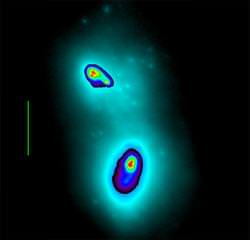Astronomers have located an ongoing galactic merger, pinpointing the exact location of each galaxy’s supermassive black hole. These twin monsters are swirling around each other, and in several million years, they’ll merge together, releasing a powerful blast of gravitational radiation.
The twin galaxies are collectively known as NGC 6240, located about 300 million light years away, and they were recently imaged by the powerful adaptive optics system of the W.M. Keck Observatory in Hawaii. Under Keck’s vision, NGC 6240 was revealed to have two rotating disks of stars, each of which had its own supermassive black hole.
Millions of years ago, these would have been two separate galaxies that got to close to one another, and began merging. This process of galactic evolution is similar to the process that built up our own Milky Way, over billions of years. Astronomers are starting to understand the connection between the black holes and the total mass of the galaxy that surrounds them. As galaxies grow, the mass of their supermassive black holes grows too.
The twin supermassive black holes are slowly falling in to a common centre of gravity. In the next 10 to 100 million years, they’ll spiral into each other and merge into a single black hole. This collision will release waves of gravitational radiation.
Original Source: UCSC News Release

